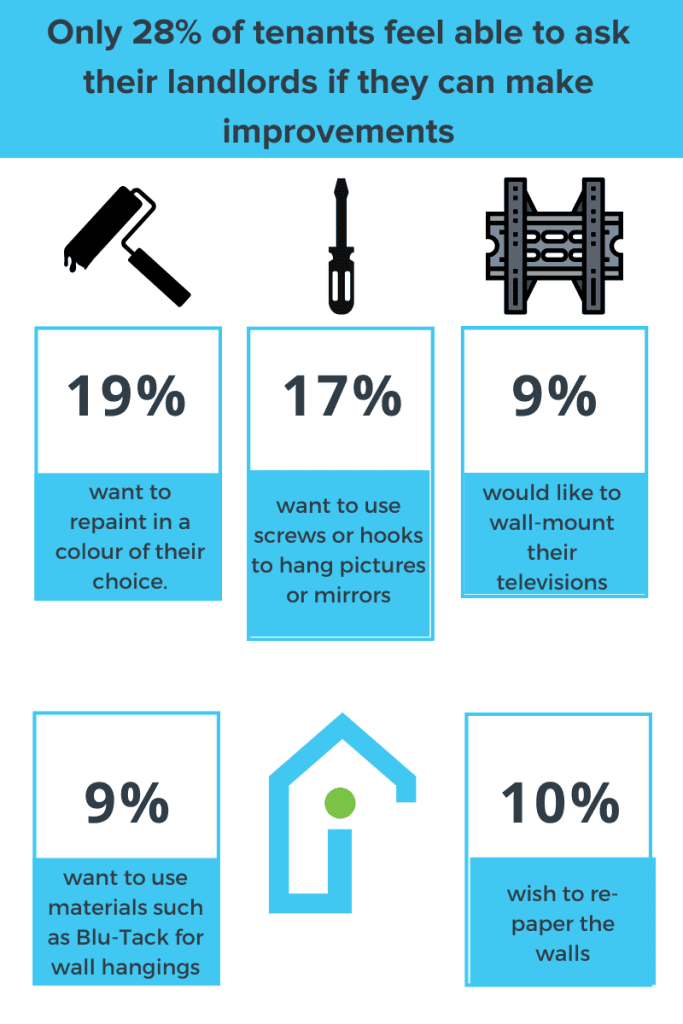For even the most accommodating landlords, their property is first and foremost a commercial asset. It’s a source of income for which they are prepared to accept maintenance responsibilities as part of the deal.
For tenants, the property has an entirely different status. It’s their home and the vast majority of tenants would love nothing more than the chance to make it comfortable and inviting. So should tenants be permitted to personalise their rental property?
According to research by Endsleigh, 43% of tenants would be happy to pay a higher rent in exchange for the right to decorate as they choose and make other modest changes.
Where does the law stand on this?
In a word, nowhere.
While there are plenty of laws and regulations governing the landlord’s obligations and issues of keeping properties fit for habitation, the questions of decoration and alteration are left entirely to the tenancy agreement. It is a matter of contract rather than housing law.
A landlord is perfectly at liberty to prohibit the tenant from making any changes whatsoever to the home.
It will be stated unequivocally in the agreement that the tenant may not paint, paper or otherwise amend the decoration, drill holes to erect shelves, alter the windows or make any reconfiguration of the property’s layout.
If that’s what the contract stipulates, then the tenant is bound and any deviation from these terms represents a breach.
Is it better to give tenants a certain amount of freedom when making alterations to the home?
For some, refusal to redecorate or make personalised changes to the home is considered a slightly draconian approach to managing rentals, which isn’t necessarily the best way to establish a good relationship with tenants. While it may seem necessary to protect the investment, it tends to over-emphasise the commercial nature of the transaction.
It’s entirely possible for the tenancy agreement to make no mention of any restrictions, but the danger for both parties is that this introduces uncertainty which might conflict with the tenants’ obligation to leave the property in good condition at the end of the tenancy.
Who is to define good conditions?
If tenants are given free rein and have a particular liking for black walls, the landlord is unlikely to be able to move a new tenant in straight after the end of a tenancy. Equally, if the walls are riddled with holes where shelves have been removed, it may take more than a few dabs of Polyfilla to make good.
Changing the curtains is one thing, but turning the property into some kind of shrine is quite another.
At Inventory Base, we’ve learnt that, as in most things, a middle way is best for all concerned. The best way to establish this is to include a clause in the tenancy agreement which clearly states that the tenant may make changes but must obtain the landlord’s permission beforehand.
It’s common to qualify this with terminology such as ‘such permission not be reasonably refused’ although that could also lead to disagreement about what constitutes ‘reasonable’.

In the same study, Endsleigh discovered that:
- only 28% of tenants feel able to ask their landlords if they can make improvements.
- of these, 76% are given the green light even when the tenancy agreement expressly excludes it.
These are the five most common changes tenants would like to make and in many cases, they need only ask:
- 19% want to repaint in a colour of their choice.
- 17% want to use screws or picture hooks to hang pictures or mirrors.
- 10% wish to re-paper the walls.
- 9% want permission to use materials such as Blu-Tack for wall hangings
- 9% would like to wall-mount their televisions.
Should tenants be permitted to personalise their home?
Apart from maintaining good relations, there’s another potential benefit in giving tenants a certain amount of freedom. If they’re able to make the home their own, they’re more likely to stay and this is attractive to most landlords, who don’t welcome the effort of finding new tenants every 12 months and the potential loss of income while looking for them.
Even if the tenants do leave, they are much more likely to spread the word about how good their landlord was and in these days of online reviews, that can lead to more business and a faster turnaround.
Let’s assume that the relationship isn’t quite so co-operative. What can the landlord do if their tenants have carried out unauthorised alterations?
The safest thing is to put clear sanctions in the tenancy agreement.
Although there are legal restrictions on the charging of fees to tenants, this falls outside that area and the landlord is entitled to specify a schedule of fines to which the tenant agrees when they sign.
If the alterations in the home are considered extreme, then it’s possible to hit the nuclear button and end the tenancy on the grounds of breach, but this could be open to legal challenge so is best kept as a last resort especially whilst the government continues is deliberations about repealing Section 21.
It could certainly be argued that the tenant should forfeit some or all of their deposit but again, this will be scrutinised under the Deposit Protection Scheme and doesn’t give the landlord carte blanche.
The importance of carrying out an inventory on the home
Once again, this highlights the importance of the work done by the inventory clerk, whose check-in, check-out and interim reports can be used to monitor and restrict what the tenant can do, including an order to reverse any unacceptable alterations.
Without being intrusive, the landlord can use the most recent property inspection to confirm that the tenant is abiding by the rules.
When all’s said and done, it’s best to avoid conflict.
Certainty in the agreement is highly desirable but so too is a reasonable, accommodating approach. It’s better for both parties to respect the wishes and boundaries of the other.

